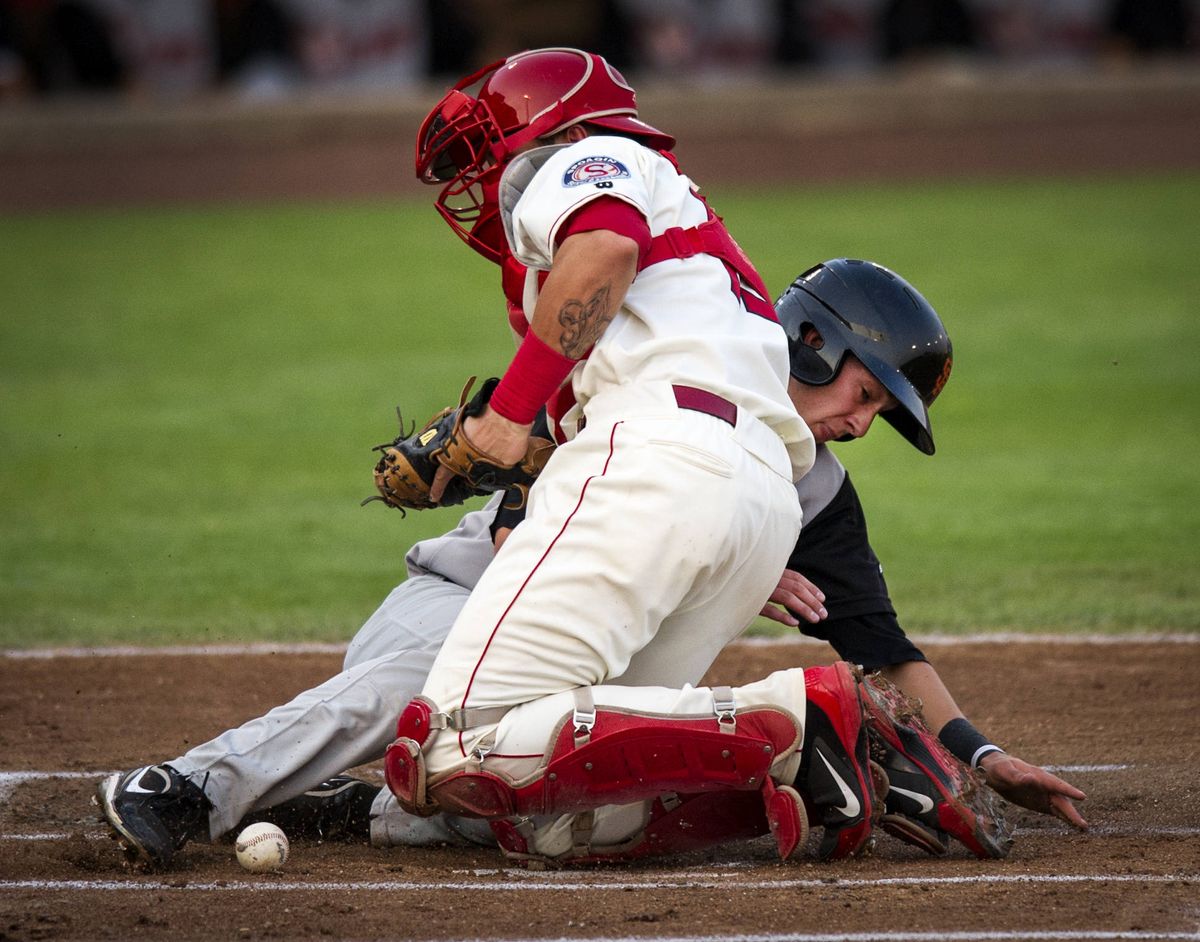Bats come alive in Indians’ final game at Avista Stadium

The strangest things happen at the ballpark in between the same old, same old.
Exhibit A: not quite four innings into Sunday evening’s 2012 home finale, the Spokane Indians were going all Bash Brothers on Salem-Keizer – their first six hits going for extra bases, including two crushed home runs that might have rolled all the way to Sprague Avenue if the railroad cars hadn’t been in the way.
But they’d scored all of four runs, and led by just one.
Yet an inning later, the Indians had added five more runs – on a pair of singles that traveled 70 feet between them.
Exhibit B: These Indians, as you may know, have not been the most prosperous outfit on the field this summer. In fact, their season record is the worst in the Northwest League, exacerbated by a 10-game losing streak in July.
So of course the announcement came down that rather than shop around for a new talent sugar daddy, they had re-upped their player development deal with the Texas Rangers for two more years.
What else?
Well, there was a 10-minute “umpire delay” after Louis Williams sustained a concussion on a foul tip and Masa Ichiki had to hustle into his mask and protector to go it alone for the last few innings.
Oh, yes, and before the game, a few of the Volcanoes were seen out in the concession area goofing on the llamas a local farm had brought in for kids to pet.
Llamas? That’s the same old, same old we mentioned. Along with the obligatory on-field marriage proposal. This is minor league baseball, after all.
Also, the last 6,074 customers turned out for the final gasp of baseball this summer in Spokane, pushing the seasonal count to 179,880 – or exactly 235 more than what the franchise has averaged for the last decade. How’s that for consistency?
Winning baseball is nice. Sunshine, free parking and fireworks are better.
The 10-4 pasting Spokane laid on the Volcanoes was a nice sendoff (the Indians have five more games in Eugene), and backed up manager Tim Hulett’s wistful acknowledgement that “this is one of those years” he wouldn’t mind seeing the season trickle on a few more weeks.
“It’s taken this team a little while to show some life,” he said, “and show what they’ve learned.”
The show has been fitful. When the Indians were at least OK on the mound, they couldn’t hit a lick. A month into the season, Hulett logged on to get the NWL stats and saw the team batting average at .209.
There’s the Mendoza Line, and then there’s the flat line.
So he and coach Oscar Bernard did triage. Every hitter was given five drills to do every day.
“If they needed something else, we’d give them that, too,” Hulett explained, “but we gave them 21 days to break an old habit and start a new one, and they bought into it. We never missed. We’d be out here early to do the work even if we got in off the road at 5 in the morning.
“Now we’re bouncing around .250, .255 and I’m proud of that.”
Then the starting pitching went to pieces as the second half started and stuggled all the way up to this last week, when it’s been outstanding. Connor Sadzeck and C.J. Edwards have thrown well, but not until his last three starts has Jose Valdespina flashed his considerable potential.
“He’s been phenomenal,” Hulett said. “If that had happened the start of the second half, we’d have been in it.”
But even with the split-season format, the Indians haven’t been in the NWL playoffs the last two summers. The cumulative back-to-back record of 61-86 to this point is the worst since 2006-07.
That wouldn’t suggest a home run for the Rangers scouting department and might cast a dubious light on that player-development renewal, except for this: seven players from that 2007 team that finished a few percentage points ahead of where this one will have played in the big leagues. Thirteen players on Texas’ 40-man roster alone have played for Hulett in six years here.
“It’s a good feeling to see those guys up there, but it’s a compliment to the whole organization,” Hulett said. “You can develop some guys, but for us to have guys on the 40-man year in, year out means they’re drafting the right ones and the development program is good enough that if they put the work in, they have a shot.”
And no matter what the standings and stats say, these Indians still do – even if they don’t appear to have been blessed with top-enders.
“I tell them this is the best job you’ll ever have – and not everybody gets this opportunity,” Hulett said. “Don’t ever let anybody – including me – tell you what you can’t do.”